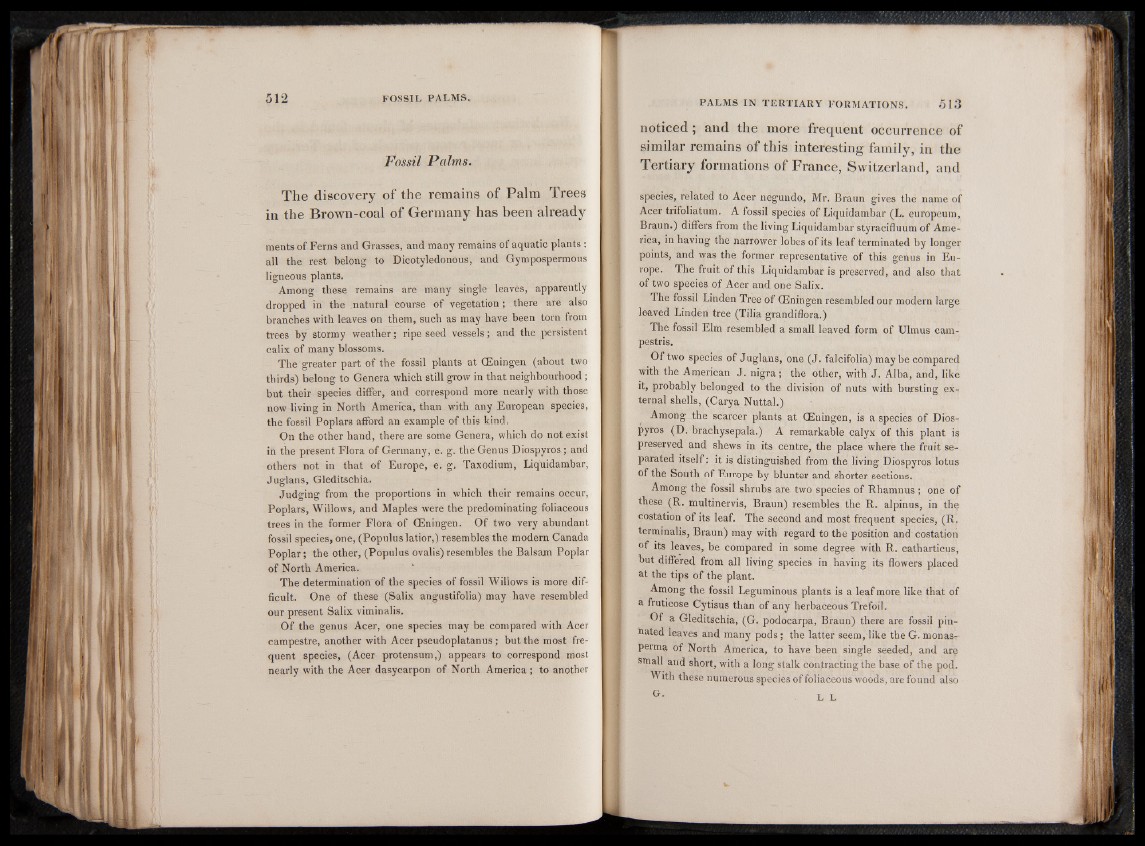
Fossil Palms.
The discovery of the remains of Palm Trees
in the Brown-coal of Germany has been already
ments of Ferns and Grasses, and many remains of aquatic plants :
all the rest belong to Dicotyledonous, and Gympospermous
ligneous plants.
Among these remains are many single leaves, apparently
dropped in the natural course of vegetation; there are also
branches with leaves on them, such as may have been torn from
trees by stormy weather; ripe seed vessels; and the persistent
calix of many blossoms.
The greater part of the fossil plants at CEningen (about two
thirds) belong to Genera which still grow in that neighbourhood ;
but their species differ, and correspond more nearly with those
now living in North America, than with any European species,
the fossil Poplars afford an example of this kind.
On the other hand, there are some Genera, which do not exist
in the present Flora of Germany, e. g. the Genus Diospyros; and
others not in that of Europe, e. g, Taxodium, Liquidambar,
Juglans, Gleditschia.
Judging from the proportions in which their remains occur,
Poplars, Willows, and Maples were the predominating foliaceous
trees in the former Flora of CEningen. Of two very abundant
fossil species, one, (Populuslatior,) resembles the modern Canada
Poplar; the other, (Populus ovalis)resembles the Balsam Poplar
of North America.
The determination of the species of fossil Willows is more difficult.
One of these (Salix angustifolia) may have resembled
our present Salix viminalis.
Of the genus Acer, one species may be compared with Acer
campestre, another with Acer pseudoplatanus; but the most frequent
species, (Acer protensum,) appears to correspond most
nearly with the Acer dasycarpon of North America ; to another
noticed; and the more frequent occurrence of
similar remains of this interesting family, in the
Tertiary formations of France, Switzerland, and
species, related to Acer negundo, Mr. Braun gives the name of
Acer trifoliatum. A fossil species of Liquidambar (L. europeum,
Braun.) differs from the living Liquidambar styracifluum of America,
in having the narrower lobes of its leaf terminated by longer
points, and was the former representative of this genus in Europe.
The fruit of this Liquidambar is preserved, and also that
of two species of Acer and one Salix.
The fossil Linden Tree of CEningen resembled our modern large
leaved Linden tree (Tilia grandiflora.)
The fossil Elm resembled a small leaved form of Ulmus cam-
pestris.
Of two species of Juglans, one (J. falcifolia) maybe compared
with the American J. nigra; the other, with J. Alba, and, like
it, probably belonged to the division of nuts with bursting external
shells, (Carya Nuttal.)
Among the scarcer plants at CEningen, is a species of Diospyros
(D. brachysepala.) A remarkable calyx of this plant is
preserved and shews in its centre, the place where the fruit separated
itself: it is distinguished from the living Diospyros lotus
of the South of Europe by blunter and shorter sections.
Among the fossil shrubs are two species of Rhamnus ; one of
these (R. multinervis, Braun) resembles the R. alpinus, in the
costation of its leaf. The second and most frequent species, (R,
terminalis, Braun) may with regard to the position and costation
of its leaves, be compared in some degree with R. catharticus,
but differed from all living species in having its flowers placed
at the tips of the plant.
Among the fossil Leguminous plants is a leaf more like that of
a fruticose Cytisus than of any herbaceous Trefoil.
Of a Gleditschia, (G. podocarpa, Braun) there are fossil pinnated
leaves and many pods; the latter seem, like the G. monas-
perma of North America, to have been single seeded, and are
small and short, with a long stalk contracting the base of the pod.
With these numerous species of foliaceous woods, are found also